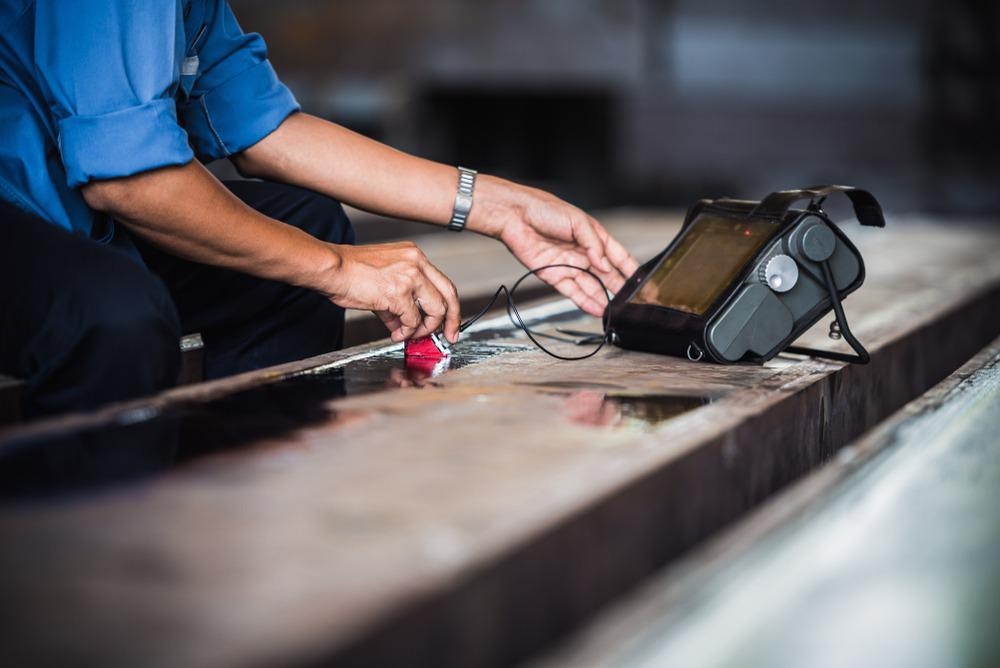Manufacturers require non-destructive testing (NDT) to analyze the qualities of a material, component, structure, or system for distinctive variations, welding faults, and discontinuity without causing harm to the original part.

Image Credit: N_Sakarin/Shutterstock.com
Why NDT for Welding is Significant
The assessment of weld quality is one of the most prevalent applications of nondestructive testing (NDT). This is due to the fact that welds are used in a wide range of vital industrial applications all over the world. Because damaging a weld for testing implies replacing it with a fresh, untested weld, the ability to check welds nondestructively is critical. As a result, the vast area of nondestructive testing procedures for welding has seen substantial technical advancement.
The Benefits of NDT of Welds
Each nondestructive welding testing method has the same purpose: to find any internal faults that might lead to weld failure. The need for testing increases as the repercussions of weld failure range from small to severe. Many welding applications might result in serious injury if they fail, necessitating extensive testing.
Welds are omnipresent in modern industrial civilization, necessitating efficient testing procedures. NDT is cost-effective since it can prevent the need to replace an item before it malfunctions without harming it.
This testing method also provides operators with a sense of security by ensuring that equipment is operating as it should, preventing future incidents, and determining any life extension measures that may be performed.
Liquid penetrant, magnetic particle, radiography, eddy current, and ultrasonic testing are the most prevalent forms of nondestructive testing for welds, omitting basic sensory inspections. The most obvious benefit is that the items being examined are left intact by the procedure, allowing an object to be fixed rather than replaced if any issues are discovered.
These methods are also relatively safe for operators, although some tests, such as radiographic testing, must still be performed under stringent guidelines.
Types of NDT for Welding and its Process Overview
Liquid Penetrant Testing (LPT)
Liquid Penetrant Testing (LPT) is a type of testing that is simple in theory but can be challenging to execute effectively. This method involves isolating a testing region before attempting to move fluid through it. If the fluid will not travel through the weld, it is considered secure.
If there are fractures or faults in the weld, the fluid will go through them as well. This not only alerts technicians to the presence of a fault but also where it may be detected. While this is a viable option, separating spaces for testing, as well as transferring and containing liquids, can be time-consuming. It also has no way of detecting sealed cavities within an item, or faults that are not visible on the surface.
Further Reading: Non-Destructive Testing of Timber
Radiography
X-rays are used in radiographic testing to examine the interior structure of welding (and other objects). This method can detect interior voids that are sealed, as well as cracks and faults detected by liquid penetrant testing. This approach can also be faster than liquid penetrant since it does not require fluid containment.
The radioactivity of this approach, on the other hand, raises severe concerns. During the testing process, non-essential individuals must be kept out of the testing area. The efficiency of radiographic testing is hampered by these safety issues, which generate logistical challenges.
Eddy Current Testing
Eddy current testing, similar to magnetic particle testing, uses electromagnetism to discover faults in welds. Eddy current procedures, especially magnetic particle testing, usually do not need any surface preparation and can function efficiently even with many layers of paint.
Eddy current testing's comparing efficiency is greatly improved as a result of this. Eddy current technology, on the other hand, is unable to detect faults deep beneath the surface of bigger welds, necessitating the employment of a different approach.
Ultrasonic Inspection
Ultrasonic testing is the primary form of nondestructive testing for welds due to its speed and capabilities. A transducer is used to deliver high-pitched acoustic waves into a weld. Internal structural changes, such as fractures, cavities, or warps, might affect the passage of sound waves through the weld.
These changes can be observed on the same side of the weld as the wave was applied, allowing the ultrasonic instrument to interpret their reflectance. Using a method known as phased array, probes with many transducers may swiftly scan a wide area of a weld's interior. Powerful software analyzes photos quickly and displays the information for technicians to act on.
The Best Welding NDT Method
While several nondestructive testing methods can uncover failure-predictive faults in welding, phased array ultrasonic testing is the most efficient and effective. Ultrasonic examinations allow personnel to execute speedy checks without losing precision, and they do so without the safety problems, labor-intensive setup, or costly auxiliary equipment of previous approaches.
Future Advancement of NDT for Welding
A new finding of an array of permanent magnets organized in a quasi-sinusoidal magnetic path could be used. The magnetic field produced by the element's initial residual magnetism is measured and saved for future use.
The magnetic field assessment is repeated after the operation. The application of stress can be determined by analyzing relative changing magnetic fields (for chosen components). The suggested approach seeks to give unambiguous and reliable information on the state of steel structures.
References
Chady, T., et al. (2022). Magnetic Recording Method (MRM) for Nondestructive Evaluation of Ferromagnetic Materials. Materials 2022, 15(2), 630; https://doi.org/10.3390/ma15020630
Sondalini, M. (2021). Non-destructive Testing of Welds. https://accendoreliability.com/non-destructive-testing-welds/
Disclaimer: The views expressed here are those of the author expressed in their private capacity and do not necessarily represent the views of AZoM.com Limited T/A AZoNetwork the owner and operator of this website. This disclaimer forms part of the Terms and conditions of use of this website.